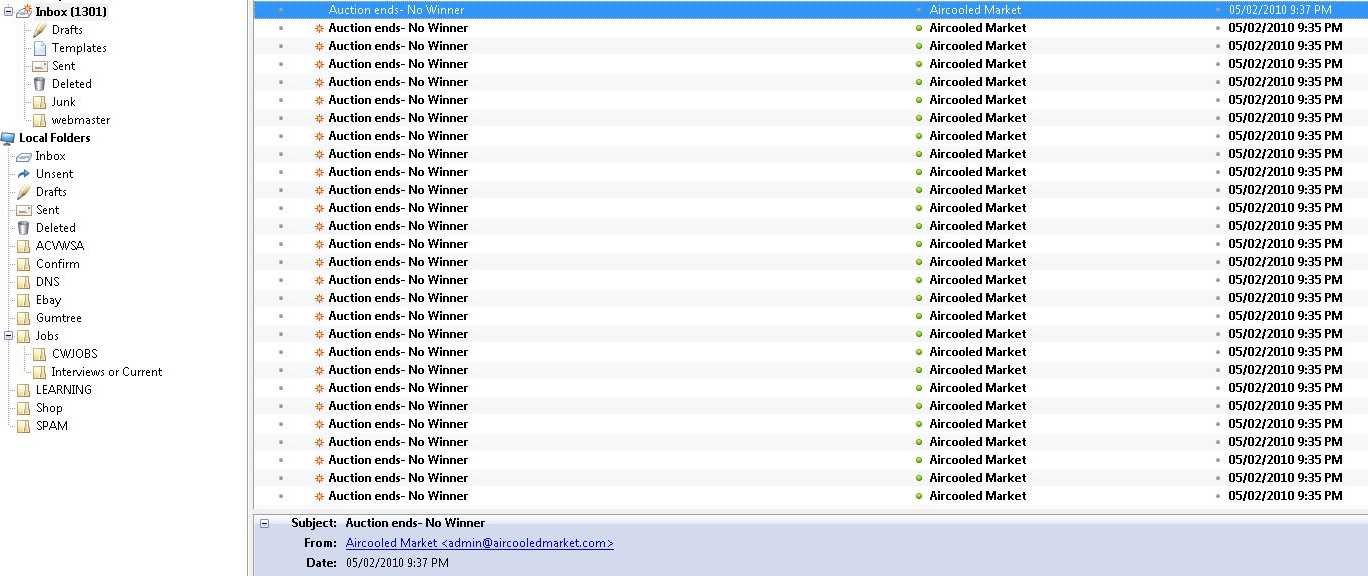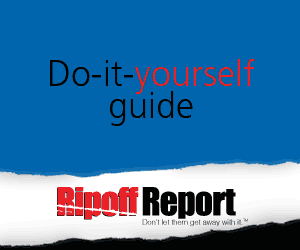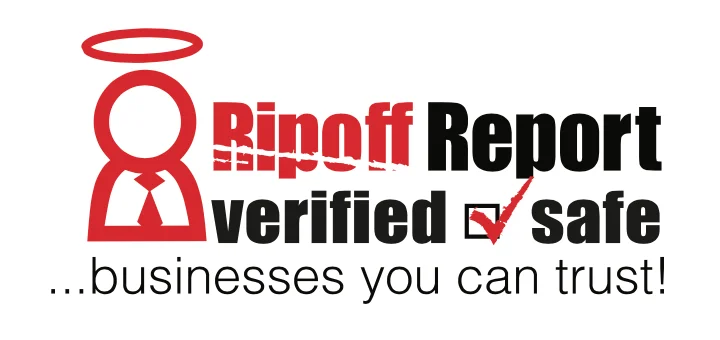Complaint Review: BPowerhouse.info - Internet
- BPowerhouse.info PB 56001 Internet United States of America
- Phone: +972 29995245
- Web: http://bpowerhouse.info/
- Category:
BPowerhouse.info BPAuction BPowerhouse.info sells incomplete BPAuction script with over 10 errors for $49 and refuse to support/refund Internet
*Consumer Comment: Again dogs life
*Consumer Comment: lie
*Author of original report: Try it yourself
*REBUTTAL Owner of company: These are features, not errors
*Author of original report: You still have my money and I have a broken script.
*REBUTTAL Owner of company: Eben van Ellewee rips off honest programmers
listed on other sites?
Those sites steal
Ripoff Report's
content.
We can get those
removed for you!
Find out more here.
Ripoff Report
willing to make a
commitment to
customer satisfaction
Click here now..
I bought this script for $49 from the internet, under the impression that it was complete and working.
- 06/02/2010 16:45 GMT - Seller: The buyer installed script succesfully and has very small issues which are not bugs at all.
- 06/02/2010 16:44 GMT - Seller: You are lying about 1304 emails. The script works excellently.
This report was posted on Ripoff Report on 02/08/2010 06:05 AM and is a permanent record located here: https://www.ripoffreport.com/reports/bpowerhouseinfo/internet/bpowerhouseinfo-bpauction-bpowerhouseinfo-sells-incomplete-bpauction-script-with-over-10-566152. The posting time indicated is Arizona local time. Arizona does not observe daylight savings so the post time may be Mountain or Pacific depending on the time of year. Ripoff Report has an exclusive license to this report. It may not be copied without the written permission of Ripoff Report. READ: Foreign websites steal our content
If you would like to see more Rip-off Reports on this company/individual, search here:
#6 Consumer Comment
Again dogs life
AUTHOR: hits0025 - ()
SUBMITTED: Thursday, April 11, 2013
Adopting a dog is a wonderful experience on many levels. In addition to a cuddly companion, you get unconditional love and unwavering devotion. In most cases, you also get your own personal security detail. Canines are naturally protective of their families, happily putting themselves in harm's way if it means saving the life of a loved one. That is, assuming your pet is able to identify a potential threat and respond appropriately. It's a skill that some dogs are better at than others.How do you know which breeds make the best family guard dogs? That depends a lot on the characteristics of your family and what you're looking for in terms of pooch-based protection. In some cases, "talkative" dogs are best at keeping away would-be evildoers. While you know that your dog's bark is much worse than its bite, criminals do not.One important consideration in choosing a family guard dog is its tendency to be aggressive. An animal with a short fuse probably isn't suitable for a family with small children. And even though an aggressive dog may seem like the perfect people protector, such animals will often respond the same way to a trespasser and a trick-or-treater. That could cause serious trouble in the neighborhood.The key to rearing a good family guard dog is to train early and often in order to build your dog's trust in you and himself. Confidence in an animal means the difference between reacting when it is important to do so and lashing out due to insecurity.Now that you know some basics about people-protecting pooches, let's explore some of the more protective breeds in our list of the top 10 family guard dogs.
One of the best things about having a small dog is being able to take him with you wherever you go, including onto airplanes. These days, most major airlines allow dogs in passenger cabins, as long as they weigh in at about 15 to 20 pounds or less. There are still a few rules you'll have to follow, though, so before you head out for your flight, you'll want to take stock of some basic things.For example, when flying with your dog, remember to keep his essential paperwork handy at all times. Sometimes called a pooch passport, this may include a recent health certificate and a special canine boarding pass issued from whichever airline you're flying. Before you head to the airport, be sure to find out exactly what paperwork the airline requires of their four-legged passengers. Once you have it all together, you should also put a copy of the pooch passport and your contact information in your dog's crate or carrier just in case you are separated from him for some reason.According the Federal Aviation Administration (FAA), airports in the U.S. -- and most everywhere else -- require that dogs be kept in carriers or crates at all times. There is, however, one exception to this rule: passing through airport security. Transportation Security Administration (TSA) regulations specify that when traveling with your pet, you'll have to remove him from his carrier and hold him as you walk through the metal detector. The carrier -- but never the dog -- will be put through the X-ray machine. And bear in mind that the screeners may ask to see your dog's boarding pass, so it's a good idea to keep that handy.A lot of people have anxiety about passing through airport security based on small dogs' uncanny ability to wriggle free from even the tightest grip. If you're one of them, ask to have your dog screened in a private room. Virtually all airports have them, and it'll alleviate the risk of losing your beloved buddy.One of the most important rules to remember when flying with your small pooch is that you won't be able to take him outside once you pass through security. That's why it's essential that your pup does his "business" before the flight. The best approach is to cut off his food and water about two hours before heading to the airport. Once you're there, be sure to take your dog out to the pet relief area -- most airports will have one -- before going through the security checkpoint. Follow these simple rules, and it'll be a bon voyage for you and your best furry friend.
A lot of small dog owners never leave home without their furry friends. And why should they? Most little dogs make great travel companions. But despite their infinite portability, it's not always easy to keep your small dog safe and happy while you're on the go. Having the right gear can help with that, though, and it's bound to make your journey more enjoyable as well.Sitting PrettyOne of the most important pieces of gear for a road-tripping pup is a good car seat or some other canine car-safety device. For diminutive dogs that like to be snug and secure in the car, consider a cushioned and flexible crate for the car. For those that like a bit more freedom and the ability to take in the sights while cruising down the road, a harness might be a better choice.There are also many great gadgets that can make participating in travel activities with your pet easy and fun. Going biking with your petite pup? Keep him close with a doggie bike basket. Unlike Dorothy's little bike basket in "The Wizard of Oz," these doggie devices are actually designed to keep your pet safe and secure.If power-walking is more your thing, you may want to consider a pet stroller. Like bicycle baskets, most pet strollers have harnesses and/or enclosures that prevent your precious canine cargo from falling and jumping out. They also allow your little friend to rest in a nice, shady spot while you enjoy a brisk stroll.Dressing for SuccessSince small dogs may not be too well-equipped to withstand the elements, you'll also want to bring along canine-specific clothing that's appropriate for the different environments your small pooch may encounter. For example, if you're headed to the ski slopes, pack a warm sweater and some doggie booties. Going boating? Don't forget a pup-approved life jacket or float coat. If you'll be active at night, consider taking a reflective vest to keep your small dog safe. These items are sold many pet stores, as well as camping and sporting goods stores, but you may find a larger selection with online retailers.
Your dog likes to wag his tail, not his toothbrush, right? But just like in humans, plaque and bacteria develop in your dog's mouth. If it's not brushed or scraped away, plaque can turn to tartar within 36 hours. Tartar buildup can lead to painful, inflamed gums, and open the door to infection and periodontal disease.Dog food and treats frequently boast their beneficial dental qualities. Tossing your pup a dental-cleansing treat is certainly easier than convincing him to let you brush his teeth! But when it comes to dental benefits, not all claims are created equal.Dry kibble has been credited with keeping teeth clean, and the crunch of dry kibble can keep teeth cleaner than a diet of wet food, which is stickier and more likely to get trapped in between teeth. But while daily kibble helps, it can't do the entire job by itself.Long-lasting chew items can offer the most cleansing benefit -- things like rubber or nylon chew toys, or rawhide or a knucklebone. Your dog should spend about 30 minutes gnawing, daily, for maximum tooth-scraping benefit. Supervise your pup with any prolonged treat, and take it away if it becomes small enough to pose a choking hazard.Whatever you choose, shop wisely. A treat with the Veterinary Oral Health Council's seal of approval means it has been studied and proved to have some dental benefits. Also, consider the size of the treat you're buying. If Fido gulps it up in seconds flat, it probably didn't have much chance to do widespread work. Although your dog won't mind eating numerous treats to maximize his cleaning potential, you don't want to trade clean teeth for a pudgy pup.It would be great if treats and chews were the doggy dental care solution, but some pooches can chew and chew and still have dental problems. We'll tell you why next.Chew on ThisYou've stocked up on some good quality chews and your dog is drooling, anxious to get to work. Don't dismiss your dental worries just yet.Smaller dogs, or breeds with a crowded or stacked bite, are more likely to have "hiding spots" in the mouth. This means that no matter how long or hard he chews, some areas in his mouth just can't be reached, so plaque will develop. And while chewing will help with the surface of the teeth, it doesn't get under the gum lines like the bristles of a toothbrush, says Dr. Santiago Peralta, DVM, specializing in dentistry and oral surgery at Cornell University.So do dental chews and treats really work? Some do have dental cleaning benefits, particularly those that are VOHC-approved, says Peralta, but there's no substitute for the benefits of toothbrushing and professional care. To keep your dog's pearly whites in the best condition, offer dental cleansing treats and chews as a supplement, but don't forgo other elements of dental care.
Here's something to chew on: According to research conducted by Euromonitor and the American Pet Products Association, worldwide sales of dog and cat food have climbed to $52 billion dollars, with nearly $18 billion attributed to the U.S. market alone. It's a staggering number, but one that makes sense when you consider the fact that, according to the Humane Society of the United States (HSUS), there are approximately 77.5 million pups and 93.6 million cats owned as pets in American households.Those numbers make for a lot of mouths to feed. There are many types of food available including wet and dry types, as well as newer trends like raw food diets and also a growing number of manufacturers to choose from including companies owned by celebrities such as talk show hosts Rachael Ray and Ellen DeGeneres and actor d**k Van Patten. The options can seem endless and even overwhelming. So how can you tell which kinds are best for your pet?
Scientists believe that all domestic dogs descend from a single pack of gray wolves that roamed China about 15,000 years ago, and all domestic cats descend from five felines that lived in the Middle East more than 100,000 years ago [source: McGourty, BBC News]. But with so much evolution between today's pets and their ancient ancestors, should Spot and Whiskers be eating the same raw food diet as their forefathers? This question became an especially hot topic of debate after a 2007 recall of more than 100 brands of processed pet food in the United States. The concern was over food containing wheat gluten contaminated with melamine, a substance used to make plastics and fertilizer. About 2,000 dogs and 2,000 cats died from ingesting tainted food [source: Mann].Scientists believe that all domestic dogs descend from a single pack of gray wolves that roamed China about 15,000 years ago, and all domestic cats descend from five felines that lived in the Middle East more than 100,000 years ago [source: McGourty, BBC News]. But with so much evolution between today's pets and their ancient ancestors, should Spot and Whiskers be eating the same raw food diet as their forefathers? This question became an especially hot topic of debate after a 2007 recall of more than 100 brands of processed pet food in the United States. The concern was over food containing wheat gluten contaminated with melamine, a substance used to make plastics and fertilizer. About 2,000 dogs and 2,000 cats died from ingesting tainted food [source: Mann].Another AlternativeA Middle Ground between Processed Kibble and Raw FoodIf you want to feed your pet something a little better than heavily-processed kibble, but you're wary of the raw food diet, you might look into high-quality bagged and canned pet food. These products can typically be identified by their labeling, which often promotes "human-grade" ingredients. The more specific the ingredient list, the better. For example, "beef" is better than "beef byproducts." You should be the most suspicious of vague ingredients like "meat byproducts meal," which may contain euthanized dogs and cats, or even road kill!Raw Pet Food Risks and How to Prepare the CuisineBefore you go out and get your pet a T-bone to munch on, consider the risks and drawbacks of the raw food diet. Foremost among these is the threat posed by Salmonella and E. coli. Present in a frighteningly large percentage of raw meat, these bacteria can cause illness and death in animals. Owners can also become infected either through direct contact with meat or through indirect contact with pet feces. Raw bones can also be hazardous. They can chip or fracture an animal's teeth, or worse, shards of bone can break off and get lodged in, or puncture, its gastrointestinal tract. Experts also question the nutritional value of raw food diets, specifically the balance of potassium, calcium, phosphorus and zinc they provide. Finally, raw food diets are expensive. Owners can expect to pay upwards of $70 a month for raw meat, fruit and veggies, while processed food can cost as little as $10 a month.If, after considering the benefits and risks, you choose to put your animal on a raw food diet, the switch can typically be made right away. However, if your pet is older or has digestive or immune problems, you'll want to introduce the raw food slowly. The key to the raw diet is variety, so there are endless ways to prepare it. A typical meal might include some type of meaty bone (chicken backs, chicken wings, turkey necks), ground meat (beef, turkey, lamb), organ meat (beef kidneys, chicken liver), whole eggs, pulverized fruits and vegetables, and supplements. For owners short on time, some companies sell prepackaged frozen patties with all of these ingredients already mixed together. Animals react in various ways to the new diet; some will eat everything you put in front of them, while others may never develop a taste for raw food. You'll have to experiment to see what they like.Remember to consult your veterinarian before making any major changes to your pet's diet.
If there's one thing you need to know about puppies, it's that they're unpredictable. Some may take to leash-walking well, others, not so much. So what are you to do if your puppy falls into the latter category? We've got some tips to help you out!Choose the Right Leash and Collar for Your PuppyThis might seem obvious, but with so many collar and leash options out there, it may be confusing which to choose. Most professionals suggest getting a light weight collar and leash so the addition doesn't seem too imposing to your puppy. Once he or she gets used to the collar, you can move onto a different kind in the future once you understand your dog's needs better.Help Your Puppy Become Accustomed to the CollarLike most kinds of training, you want to make sure your puppy feels safe and secure while you're helping him get used to his collar and walking on a leash. Since simply adding a collar might result in a temper tantrum or cause your pup to become fearful or nervous, try slipping it on at a time when there are other distractions to occupy your puppy's mind. Try putting it on when you're interacting with him at home, or taking him out into the yard with you, or feeding him. Associating the collar and leash with food will give positive reinforcement to your pup, making it less stressful for both of you. If your puppy scratches at the collar, try to get his attention to distract him from the new addition around his neck. If that fails, bringing out a favorite toy should help.Attach the Leash to the CollarSeems pretty simple right? You'd be surprised. Often a dog will tend to run around like crazy once he feels some tension on the end of the leash. To avoid this, attach the leash and let him run around while it drags on the ground. Obviously only try this in an area where you can supervise your pup to make sure he doesn't run off and to avoid any entanglements. Ideally, you should try this when there is another dog around so your pup can play while wearing the leash. If this isn't possible, simply play with your dog or go through a fun training routine, rewarding him with a treat. While doing this, occasionally pick up leash and call him to you. The trick is to encourage him while gently picking up the leash, again rewarding him with small treats.Learning to Walk With the Leash onIf your dog naturally walks at heel, that's great - but don't expect it - and don't try to get him to. Yanking on the leash won't help the situation, so think of getting him to walk as a gradual process. You may need to stand still or kneel down while he figures out what's going on - that way your pup realizes that he won't be able to go anywhere unless it is by your side. Some dogs may decide to sit down and not move. If this happens, call to your pup and offer him a reward when he comes over. Never yank him toward you. Once he comes over of his own will, offer him a treat and continue walking with him by your side.Final TipsLeash-training your puppy may be frustrating, but it's important to take your time and remain calm. Your puppy may not get leash-training on his first try, so it's important to take it slow and guage how quick your little one is able to learn. Small steps will soon lead to big gains - and soon enough your puppy will be walking nicely on his leash with you.
Congratulations! You've decided to adopt a puppy or have already brought a new puppy to his forever home. Whether you're experienced with pets or adopting for the first time, here are ten helpful tips to help with your active puppy!One: Prepare Your Home for Your New PuppyJust like one would baby-proof their home for a new child, so should you for your new puppy. Why? You would not believe just how much your puppy can get into. Also, it's important to provide a safe and comfortable environment for your puppy. Start by removing poisonous plants and toxins, purchasing electrical cord protectors from your local hardware store, and removing anything that he could potentially chew. Make sure that you have plenty of safe chew toys for your puppy so he doesn't destroy things he shouldn't (like your shoes)!Two: Take Your Puppy to the VetWhile most shelters will do their best to provide for the puppies while in their care, it's impossible for them to diagnose and treat every pet. So one of the first things you should do after bringing your puppy home is set up a vet appointment to get him checked out. Your vet will also be able to provide important information on vaccinations, flea and tick control and more. Most recommend that you set up the vet appointment within the first two weeks of bringing your new puppy home since it's discouraged to take your puppy to public places before properly vaccinated.Three: Start Socializing Your Pup EarlyThe best age to socialize your pup is between 3 and 12 weeks of age. After 12 weeks, it becomes increasingly difficult to introduce your puppy to new places, people and things. For tips on how to socialize your puppy, check out this article.Four: Exercise Your Puppy RegularlyChances are your new puppy will be a little bundle of energy (when he's not napping, that is). Making sure he gets the right amount of exercise is important to his overall health. One of the easiest ways to exercise your puppy is with a daily walk. For tips on leash-training your puppy, check out this article.Five: Housebreak Your PuppyThis can be a time-consuming process. It's important to know that your puppy should be taken out about every two hours up to six times a day - and especially after meals. You should look for signs that your puppy has to go and attempt to get him on a regular schedule. If you aren't able to take him out with that great of frequency, you should crate train your puppy or limit his roaming access by gating him into a small space like a bathroom or kitchen. Most dogs will not soil where they sleep. But above all, be consistent in whatever method you choose - this is key to getting your puppy on track!Six: Know Who to TrustIt's easy to turn to the Internet if your puppy is behaving strangely or has hurt himself or if you just want general advice. However, not everyone on the Internet knows as much as your vet will. If you have a concern about your pet's health or behavior, trust your gut and make an appointment with your vet to get him checked out as soon as possible.Seven: Reward Your Puppy's Good BehaviorIn the first few weeks that you have your puppy at home, it may seem that he's misbehaving more than he's behaving. Even so, it's important to reward your puppy whenever he does something good as that will help him understand better and learn quicker. Waiting til he's misbehaving to give him attention won't help him or you!Eight: Obedience Train Your PuppyWhile the benefits of getting a new puppy far outweigh any negatives, that doesn't mean that everyday with your new pup will be perfect. In order to help your puppy quickly learn what you expect of him and how he should behave, attempt to teach him skills such as sitting for a treat or coming when called. Proper obedience courses for puppies usually don't begin until they're three to four months in age (mostly to make sure dogs are properly vaccinated), so once your pup is ready to go, enroll him in a class to learn more basic skills.Nine: Be ConsistentOne of the best things you can do for your pet is be consistent in how you raise him in your home. Be good about serving meals at regular times and taking him out around the same time each day. If you reward your puppy for doing something, don't reprimand him for it later. Your puppy will get used to you and will come to understand how things work in your home.Ten: Enjoy Your New Puppy and Take Lots of Photos!Your puppy will grow up so fast, so be sure to enjoy every moment with him - even if he can be frustrating from time to time. You've done a great thing by giving your puppy a forever home - be sure to enjoy your time together! Document your moments together by taking many photos - people will want to see your new little bundle of joy.
#5 Consumer Comment
lie
AUTHOR: hits0025 - (United States of America)
SUBMITTED: Friday, August 26, 2011
Golden Retriever is a great family dog. They are friendly and great kids. They are usually easy to train, because they are very loyal, would like their owners. Although
there are many great aspects, because a golden retriever, you still
need to spend some time training them to follow the rules of the new
homes. Like having a new baby, you have the responsibility to teach them the correct place on the toilet, and how to act at home.
It is recommended that you take the first few days, they are the dog and in your home all day with them. You need to introduce them and the voice of the people, they will have access to your home. Your first task should be to train them to use the bathroom outdoors. You can do this by taking these outside every half hour or so to sniff out the yard area. If you want them to use the bathroom in some areas of the yard, take them and walk them to the belt in the region.
Waiting for them, until they do their business. Be sure to offer great praise when they urinate or defecate in the area you want them to use at any time. This will encourage them to when they need for this.
You should also spend some time walking around them neighbors. This will teach them to go with you, and their shackles, will also familiarize them with the new environment. They are likely to be exposed to other dogs in the vicinity. They will hear them barking, and know that this is part of their new environment.
You should determine what kind of rules in your home as well. Would you let your new puppy to get up the furniture? They were allowed to sleep in the bed, you or your family member? These rules, you will have to implement from the beginning, so that the new puppy will know what they are not allowed to do.
If you do not want the dog to be in the furniture, then you should let them run free at home. When
you see they are trying to get up on the furniture, then you should
immediately push them down gently to the ground, and told them "no." To do so several times, they will stop trying to get up the furniture.
Positive reinforcement is a great way to teach your new Golden Retriever puppy's behavior the way you want them. Treatment
to keep some on hand, so that when they are good, they learn new
skills, you can give them a positive return on positive behavior. Your
dog needs your guidance so be sure to tell them that love and
appreciation, they are good, let them know you are not happy when they
make mistakes. They will make mistakes, but to keep their training, you will find your new dog is a great addition to your family.
Golden Retriever is a great family dog. They are friendly and great kids. They are usually easy to train, because they are very loyal, would like their owners.
#4 Author of original report
Try it yourself
AUTHOR: Tricked_Consumer - (United Kingdom)
SUBMITTED: Tuesday, February 09, 2010
Instead of enduring the name-calling and lies, I have done the following.
#3 REBUTTAL Owner of company
These are features, not errors
AUTHOR: hits0018 - (USA)
SUBMITTED: Tuesday, February 09, 2010
You saw demo, you could ask questions about features before buying. Nobody tried to cheat you, you cheated yourself. The car has 4 wheels, don't lie. It's like you thought that car has airbag and it doesn't. You tried to get our work for free, so you tried to cheat not me. And I'm sure you'll use our script, you know very well that its real cost is much more than $49.
#2 Author of original report
You still have my money and I have a broken script.
AUTHOR: Tricked_Consumer - (United Kingdom)
SUBMITTED: Monday, February 08, 2010
What do you call those things I listed then?
#1 REBUTTAL Owner of company
Eben van Ellewee rips off honest programmers
AUTHOR: hits0018 - (USA)
SUBMITTED: Monday, February 08, 2010
Eben van Ellewee bought our script and successfully installed it. Please see his list of "errors". Country list is not editable. It's constant table which normally should not be modified. Compulsory seller "Membership fee" cannot be disabled. It's obvious addition, so

Advertisers above have met our
strict standards for business conduct.




































